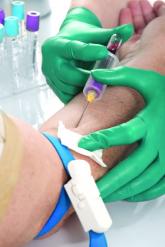News

Methotrexate plus leflunomide proves effective for PsA
- Author:
- Steve Cimino
The combination therapy outperformed methotrexate monotherapy as a treatment option for patients with psoriatic arthritis (PsA), though it did...
News

EULAR CVD management guidance focuses on gout, lupus, vasculitis
- Author:
- Steve Cimino
The recommendations advise on managing cardiovascular health in patients with gout, vasculitis, systemic sclerosis, myositis, Sjögren syndrome,...
News
PACAP38- and VIP-induced cluster headache attacks do not appear to alter CGRP levels
- Author:
- Steve Cimino
Is CGRP the missing link for patients who begin a cluster attack, or should we be looking elsewhere?
News

Updated guidance for COVID vaccination in rheumatology patients arrives amid continued hesitancy
- Author:
- Steve Cimino
A fifth update to the American College of Rheumatology’s guidelines makes new recommendations on supplemental and booster doses in patients with...
News

A range of healthy dietary patterns can reduce risk of gout in women
- Author:
- Steve Cimino
A study of four different healthy eating patterns in women found that all reduced the risk of new-onset gout in women, compared with a traditional...
News
Ketamine nasal spray provides slow-acting relief for cluster headache attacks
- Author:
- Steve Cimino
This proof-of-concept trial provides “critical information and paves the way for subsequent placebo-controlled studies.”
News

Proactive infliximab monitoring found best for sustaining control of inflammatory diseases
- Author:
- Steve Cimino
Proactive therapeutic drug monitoring with maintenance infliximab proved more effective in sustaining disease control than did standard care in...
News

Guselkumab’s efficacy, safety confirmed in patients with psoriatic arthritis and prior TNFi exposure
- Author:
- Steve Cimino
COSMOS trial results in patients with psoriatic arthritis fit with the expectation that “people who’ve previously failed a TNF inhibitor might be...
News

Largest ever review of new daily persistent headache assesses its clinical features
- Author:
- Steve Cimino
“Future prospective studies are needed to better understand this disabling disorder.”
News

PT may lower risk of long-term opioid use after knee replacement
- Author:
- Steve Cimino
When patients who have undergone total knee replacement also undergo physical therapy soon after, the likelihood of long-term opioid use after...
News

PRP injections don’t top placebo for ankle osteoarthritis
- Author:
- Steve Cimino
Results from a double-blind, randomized clinical trial provide the first high-level evidence showing a lack of efficacy for platelet-rich plasma...
News

Few JAK inhibitor users have diminished immune response to COVID-19 vaccines
- Author:
- Steve Cimino
Most patients taking JAK inhibitors had seemingly adequate immune responses based on serologic assessment of detectable antibodies, but those...
News

Study of biologics’ impact on psoriasis-to-PsA transition contradicts previous findings
- Author:
- Steve Cimino
Differing patient selection criteria and other biases may be why results from a large EHR administrative database study contradict those from...
News

Assessing headache severity via migraine symptoms can help predict outcomes
- Author:
- Steve Cimino
“Our hope is that this work serves as foundational basis for better understanding the complexity of headache as a symptom-based condition.”
News

Researchers describe first reports of breakthrough COVID infections, booster shots in rheumatology patients
- Author:
- Steve Cimino
The first published results of breakthrough SARS-CoV-2 infection in fully or partially vaccinated patients with RMDs hint at encouraging low rates...
